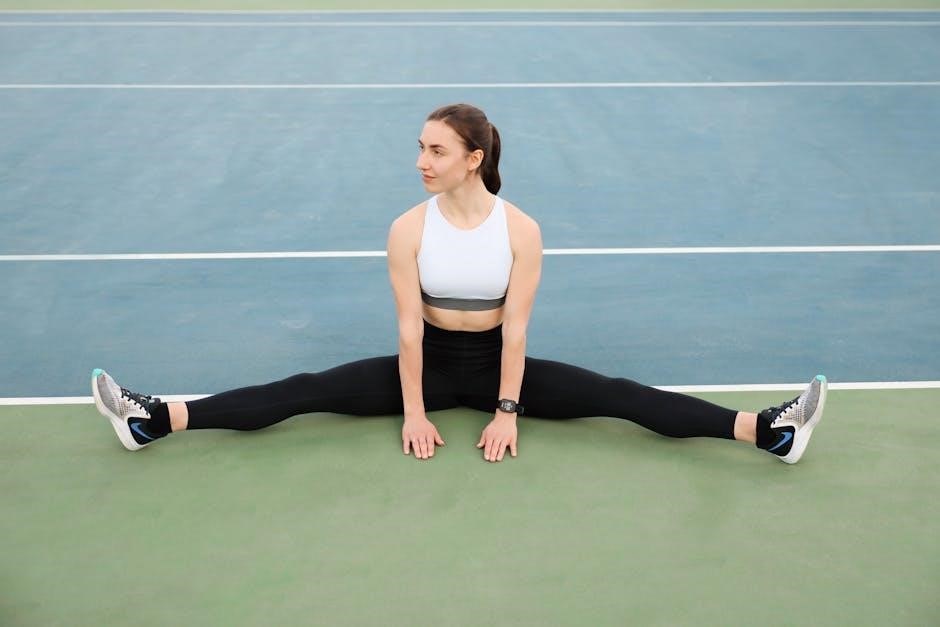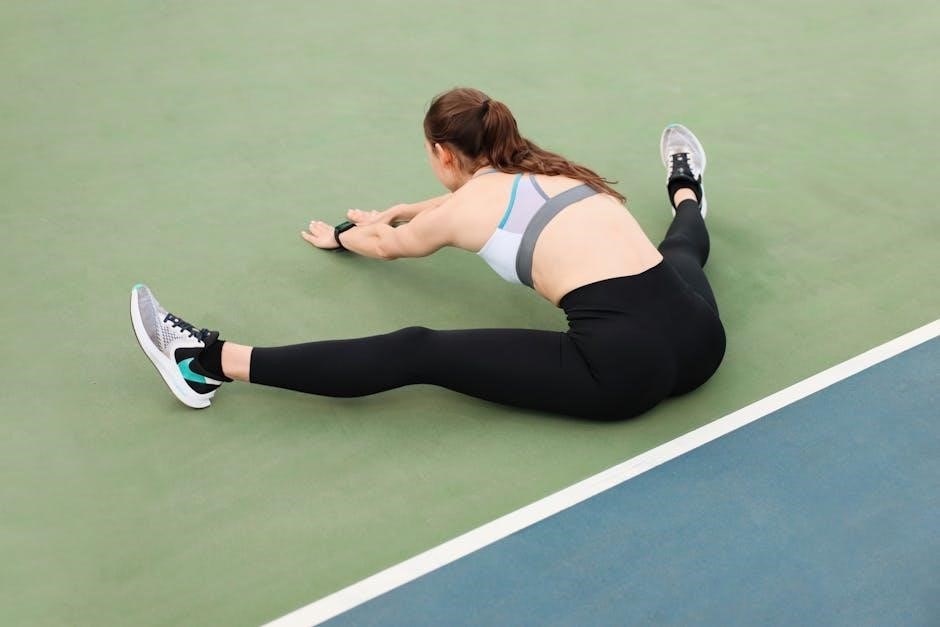
A printable rotator cuff exercises PDF is a convenient resource for shoulder rehabilitation, offering step-by-step routines to strengthen, stretch, and stabilize the rotator cuff muscles.

What is a Rotator Cuff?
The rotator cuff is a group of four muscles and their tendons that surround the shoulder joint, providing stability and enabling a wide range of motions. These muscles include the supraspinatus, infraspinatus, teres minor, and subscapularis. Together, they form a cuff that holds the humerus (upper arm bone) in the shoulder socket, allowing actions like lifting, rotating, and stabilizing the arm. The rotator cuff is essential for maintaining proper shoulder function and preventing injuries or degenerative conditions.
Understanding the rotator cuff is crucial for rehabilitation, as injuries to these muscles or tendons are common and can significantly limit mobility and strength. A printable rotator cuff exercises PDF often includes routines tailored to strengthen and protect these vital muscles.

Importance of Rotator Cuff Exercises

Rotator cuff exercises are essential for maintaining shoulder health, preventing injuries, and aiding in rehabilitation after injuries or surgery. These exercises strengthen the muscles and tendons surrounding the shoulder joint, improving stability and flexibility. Regular practice can reduce the risk of strains, tears, and chronic pain, while also enhancing overall mobility and function. For individuals recovering from rotator cuff injuries, consistent exercise routines are crucial for restoring strength and promoting healing. Additionally, these exercises are often low-impact and can be performed at home, making them a convenient and effective option for long-term shoulder care. Incorporating rotator cuff exercises into a daily or weekly routine can significantly improve quality of life and athletic performance.
Benefits of Using a Printable PDF Guide
A printable rotator cuff exercises PDF offers numerous advantages for individuals seeking to improve shoulder health. It provides a structured, easy-to-follow guide that can be accessed anytime, eliminating the need for internet connectivity. The PDF format ensures that exercises are presented clearly, often with accompanying images or illustrations, making it easier to understand proper form and technique. Portability is another key benefit, as users can carry the guide to physical therapy sessions, gyms, or anywhere they choose to exercise. Additionally, printable PDFs allow for personalized notes and progress tracking, enhancing adherence to rehabilitation or strengthening programs. This practical tool empowers users to take an active role in their shoulder care, ensuring consistency and effectiveness in their exercise routines.

Essential Rotator Cuff Exercises
This section outlines key exercises targeting the rotator cuff, focusing on strengthening, stretching, and stabilizing the muscles to improve shoulder mobility, reduce pain, and prevent injury.
Strengthening Exercises
Strengthening exercises for the rotator cuff focus on building muscle endurance and power, essential for shoulder stability and injury prevention. Common exercises include shoulder external rotations, internal rotations, and overhead presses. These can be performed with light dumbbells or resistance bands, ensuring proper form to avoid strain. Progression involves increasing resistance gradually, while maintaining controlled movements. Consistency is key to rebuilding strength and supporting the shoulder joint effectively. These exercises are often recommended post-injury or surgery to restore functional mobility and reduce pain over time. Regular practice helps prevent future injuries and enhances overall shoulder health.
Stretching Exercises
Stretching exercises are vital for improving flexibility and reducing stiffness in the rotator cuff muscles. These exercises target the shoulder region, promoting better range of motion and reducing the risk of injury. Common stretches include cross-body stretches, shoulder flexion stretches, and wall slides. Each stretch should be held for 20-30 seconds to maximize effectiveness. Proper technique is essential to avoid overstretching or causing discomfort. Stretching exercises are often performed after strengthening routines to enhance muscle recovery and relaxation. Regular stretching helps maintain shoulder mobility and supports long-term rehabilitation goals. Consistency and gentle progression are key to achieving optimal results and preventing future stiffness.
Isometric Exercises
Isometric exercises are an excellent way to strengthen the rotator cuff without movement, making them ideal for early rehabilitation or when mobility is limited. These exercises involve contracting the shoulder muscles while keeping the arm still. Examples include shoulder blade squeezes, wall slides, and isometric external rotations. Holding each contraction for 5-10 seconds and repeating for 3 sets can enhance muscle endurance and stability. Isometric exercises are low-impact and reduce the risk of further injury, making them suitable for individuals recovering from surgery or severe strains. They also improve proprioception, helping the shoulder joint function more efficiently. Incorporating isometric exercises into a daily routine can promote healing and lay a strong foundation for more dynamic movements as recovery progresses.
Dynamic Strengthening Exercises
Dynamic strengthening exercises are essential for restoring rotator cuff function, focusing on controlled movements that enhance strength and mobility. Examples include arm circles, resisted external rotations, and shoulder rotations using resistance bands or light dumbbells. These exercises progress from light to moderate resistance, helping to rebuild muscle endurance and power. Proper form is crucial to avoid strain, with a focus on smooth, deliberate movements. Dynamic exercises not only improve joint stability but also prepare the shoulder for daily activities and sports. They are particularly effective in later stages of rehabilitation, helping to transition from isometric to more active movements. Consistency and gradual progression ensure optimal recovery and reduced risk of future injuries.

How to Use the Printable Rotator Cuff Exercises PDF
Start with a neutral shoulder position, follow step-by-step guides for each exercise, and gradually increase resistance as strength improves. Always consult a healthcare provider to ensure proper form and progression.
Step-by-Step Guide to Implementing the Exercises
Begin by positioning your shoulders in a relaxed, neutral position to ensure proper form. Start with gentle movements, such as arm raises or rotations, and progress gradually. Use resistance bands or light dumbbells (1-5lbs) as instructed. Perform each exercise slowly, holding isometric positions for 5 seconds when required. Monitor your form by using a mirror or recording your movements. Adjust resistance and repetitions based on your strength level. Prioritize controlled motions to avoid strain. Consult a healthcare provider to tailor the exercises to your specific injury or surgery needs. Consistency is key—aim for 2-3 sessions per week and track your progress to ensure safe and effective rehabilitation.

Progression and Modification of Exercises
As strength improves, gradually increase resistance or weight, but never exceed 5lbs to avoid overloading the rotator cuff. Introduce dynamic movements like shoulder rotations with resistance bands. For advanced stages, incorporate exercises like wall slides or side-lying external rotations. Modify exercises by reducing repetitions or resistance if pain occurs. Substitute standing exercises with seated alternatives to reduce strain. Focus on controlled movements and avoid bouncing or jerking. Tailor the program based on individual recovery progress, ensuring each step challenges the muscles without causing discomfort. Regularly assess and adjust the routine to maintain effectiveness and prevent plateaus in rehabilitation.

Safety Tips and Precautions
Always start with a relaxed shoulder position and avoid heavy weights. Stop exercises if pain occurs, ensuring proper form to prevent injury. Warm-up beforehand is essential.

Avoiding Injury During Exercises
To prevent injury, begin exercises with no resistance and gradually incorporate light weights, up to 1-5lbs. Avoid using heavier weights as they can strain the smaller rotator cuff muscles. Ensure proper posture and maintain a neutral shoulder position before starting any routine. If pain occurs, stop the exercise immediately. Warm-up routines are crucial to prepare the muscles for activity. Additionally, using a resistance band or light dumbbells can help avoid strain. Always follow the guidance of a healthcare professional or physical therapist to tailor exercises to your specific needs and avoid overexertion. Proper technique is key to safely and effectively strengthening the rotator cuff.

Importance of Proper Form and Technique
Maintaining proper form and technique is crucial during rotator cuff exercises to ensure effectiveness and prevent further injury. Start with a neutral shoulder position and relaxed posture to promote normal shoulder function. Avoid compensating with other muscles, as this can lead to poor mechanics and potential harm. Focus on controlled movements, especially during exercises like arm raises or external rotations. Improper form may result in strained muscles or inadequate strengthening of the rotator cuff. Always prioritize slow, deliberate actions over speed or heavy resistance. Consulting a physical therapist or healthcare provider can help refine your technique and ensure a safe, effective rehabilitation process.
Final Thoughts on Rotator Cuff Rehabilitation
Printable rotator cuff exercises PDFs are excellent tools for guiding rehabilitation, offering structured routines to enhance strength, flexibility, and stability. For optimal results, combine these exercises with professional guidance to ensure proper form and progression. Consistency and patience are key, as recovery requires time and dedication. Incorporating a mix of isometric, stretching, and strengthening exercises can prevent future injuries and improve overall shoulder function. Always prioritize proper technique to avoid aggravating the condition. Digital resources, such as video tutorials, can complement the PDF guide, providing visual cues for accurate execution. Remember, rehabilitation is a journey, and adherence to a well-rounded program will yield the best outcomes for long-term shoulder health.
Recommended Additional Reading and Tools
For a comprehensive approach to rotator cuff rehabilitation, consider supplementing your printable PDF guide with additional resources. Video-based exercise platforms offer visual guidance, ensuring proper form and technique. Mobile apps like Rehab My Patient provide customizable exercise programs and progress tracking. Books such as Shoulder Pain? The Solution offer in-depth insights into shoulder anatomy and recovery strategies. Online forums and communities, like those on Physiotherapy Toolbox, connect you with professionals and individuals sharing tips and experiences. Lastly, websites such as OrthoInfo and SportsMD provide evidence-based articles and exercise tutorials. Combining these tools with your printable guide enhances your rehabilitation journey.
- Video tutorials for visual exercise guidance.
- Rehabilitation apps for personalized tracking.
- Books on shoulder health for deeper understanding.
- Online forums for community support.
- Medical websites for evidence-based advice.